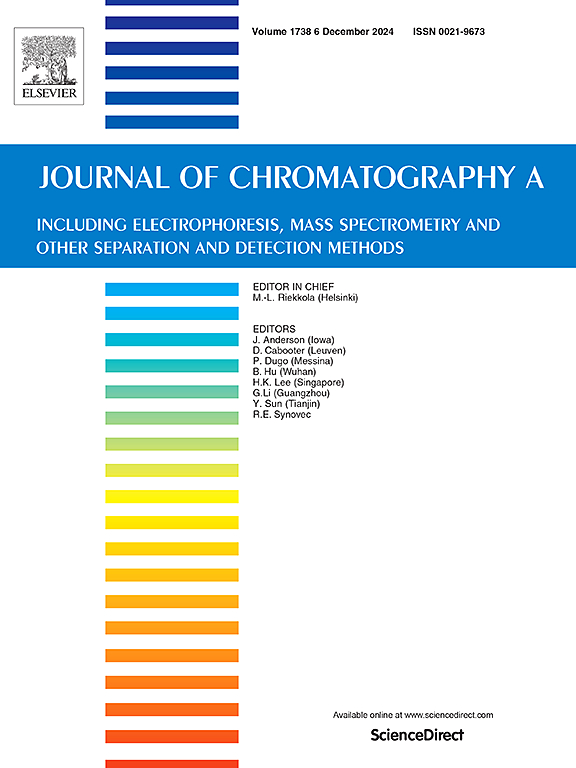Innovative analytical methodology for skin anti-aging compounds discovery from plant extracts: Integration of High-Performance Thin-Layer Chromatography-in vitro spectrophotometry bioassays with multivariate modeling and molecular docking
IF 4
2区 化学
Q1 BIOCHEMICAL RESEARCH METHODS
引用次数: 0
Abstract
Skin aging, characterized by reduced elasticity, wrinkles, and changes in pigmentation, presents significant challenges in the cosmetics industry. Identifying compounds that can help mitigate these effects is crucial to developing effective anti-aging treatments and improving skin health. An advanced analytical approach for identifying skin anti-aging compounds within complex natural mixtures must be developed to achieve this.
This study introduces a state-of-the-art methodology that combines High-Performance Thin-Layer Chromatography (HPTLC) and in vitro skin anti-aging spectrophotometry bioassays with regression multivariate analysis and molecular docking. The proposed methodology integrates spectrophotometric assays for tyrosinase inhibition (anti-pigmentation), elastase inhibition (anti-wrinkle), and radical scavenging capacity (DPPH•/ ABTS• assays) with analytical signals obtained from HPTLC chromatograms using Partial Least Squares models (PLS). The PLS models for predicting elastase inhibition and antioxidative capacity showed high accuracy with minimal errors. This study introduces an innovative approach combining HPTLC profiling and PLS regression to identify single phenolic compounds/bands responsible for anti-aging effects. In addition, identified bioactives were submitted to molecular docking studies to elucidate the enzyme inhibition mechanisms of elastase and confirm our approach. This integrated, simple, cost-effective, and high-throughput approach represents a significant advancement in the discovery of anti-aging compounds, with promising implications for future skincare and therapeutic applications.
从植物提取物中发现皮肤抗衰老化合物的创新分析方法:高效薄层色谱-体外分光光度法生物测定与多元建模和分子对接的集成。
皮肤老化,其特点是减少弹性,皱纹和色素沉着的变化,提出了重大挑战,在化妆品行业。识别有助于减轻这些影响的化合物对于开发有效的抗衰老疗法和改善皮肤健康至关重要。为了实现这一目标,必须开发一种先进的分析方法来识别复杂的天然混合物中的皮肤抗衰老化合物。本研究介绍了一种结合高效薄层色谱(HPTLC)和体外皮肤抗衰老分光光度法的生物测定方法,并结合回归多元分析和分子对接。该方法将酪氨酸酶抑制(抗色素沉淀)、弹性酶抑制(抗皱)和自由基清除能力(DPPH•/ ABTS•测定)的分光光度分析与使用偏最小二乘模型(PLS)从HPTLC色谱获得的分析信号相结合。PLS模型预测弹性酶抑制和抗氧化能力显示出高精度和最小的误差。本研究介绍了一种结合HPTLC分析和PLS回归的创新方法,以鉴定抗衰老作用的单一酚类化合物/波段。此外,鉴定出的生物活性被提交给分子对接研究,以阐明弹性酶的酶抑制机制,并证实我们的方法。这种综合、简单、经济、高通量的方法代表了发现抗衰老化合物的重大进步,对未来的皮肤护理和治疗应用具有重要意义。
本文章由计算机程序翻译,如有差异,请以英文原文为准。
求助全文
约1分钟内获得全文
求助全文
来源期刊

Journal of Chromatography A
化学-分析化学
CiteScore
7.90
自引率
14.60%
发文量
742
审稿时长
45 days
期刊介绍:
The Journal of Chromatography A provides a forum for the publication of original research and critical reviews on all aspects of fundamental and applied separation science. The scope of the journal includes chromatography and related techniques, electromigration techniques (e.g. electrophoresis, electrochromatography), hyphenated and other multi-dimensional techniques, sample preparation, and detection methods such as mass spectrometry. Contributions consist mainly of research papers dealing with the theory of separation methods, instrumental developments and analytical and preparative applications of general interest.
 求助内容:
求助内容: 应助结果提醒方式:
应助结果提醒方式:


